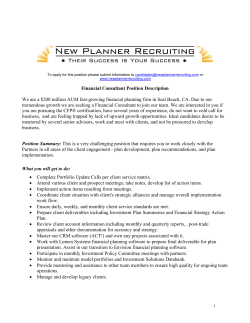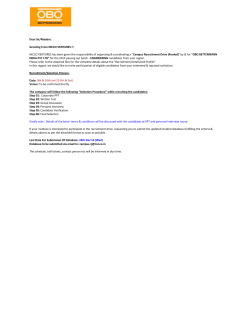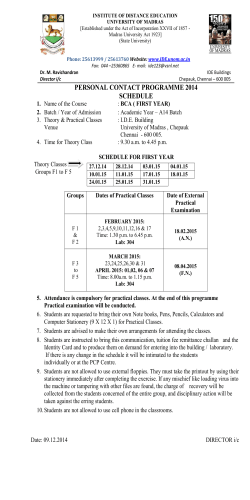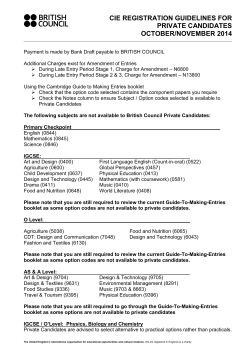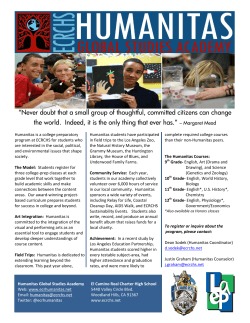
Call for applications 2015 - Humanitas University Medical
CALL FOR APPLICATIONS FOR NON-EU CITIZENS NON-RESIDENT IN ITALY TO THE ONE-CYCLE DEGREE COURSE IN MEDICINE AND SURGERY WITH LIMITED ACCESS (Class LM-41) IN ENGLISH AT HUMANITAS UNIVERSITY SUMMARY OF THE CALL IN ENGLISH Academic year 2015/2016 Foreword The official source of the Call for Applications for non-EU citizens non-resident in Italy is “BANDO DI CONCORSO, RISERVATO AI CITTADINI NON COMUNITARI NON STABILMENTE RESIDENTI IN ITALIA, PER L’AMMISSIONE AL CORSO DI LAUREA MAGISTRALE A CICLO UNICO IN MEDICINA E CHIRURGIA (Classe LM-41) IN LINGUA INGLESE DI HUMANITAS UNIVERSITY” in Italian. This document represents a summary of the call. This document is provided for the convenience of international students. In the event of disputes, the parties should refer only to the document in Italian. Admittance to the Degree Course is subject to selection through the University’s admissions test. Art. 1 Number of places available For the academic year 2015/16, the number of places available for non-EU citizens non-resident in Italy is established as 20. The number of places available may change in accordance with a later Decree of the Ministry of Education, University and Research (M.I.U.R.), pursuant to the provisions of Law n. 264, August 2, 1999. The Decree of MIUR could confirm, increase or decrease the number of places available. Art. 2 Admission requirements The following candidates are NOT entitled to apply for the present call of applications on penalty of exclusion: Citizens of Italy and of European Union member states. The citizens of Norway, Iceland, Liechtenstein, Switzerland, the Republic of San Marino. Non-EU citizens holding a residence permit for employment or self-employment, for family reasons, political asylum, asylum for humanitarian or religious reasons. Non-EU citizens legally resident from at least one year in possession of a Secondary School Diploma obtained in Italy. Non-EU citizens, resident anywhere who hold diplomas from Italian schools abroad or foreign or international schools having bilateral agreements or special regulations for the recognition of qualifications and who satisfy the general conditions required to be admitted to study in Italy. Refugees. Diplomatic personnel accredited to International Organizations in Italy, Italian State, Vatican State and their dependants. Citizens holding a European citizenship together with a citizenship of a country not belonging to the European Union. Candidates applying and participating in the test without the possession of the citizenship requirements will not be considered for the ranking. Furthermore they will be excluded from the participation to Admissions Test reserved to EU citizens and EU-equated citizens. To apply for the admissions test, candidates must satisfy one of the following: enrolled in the last year of secondary school to obtain a Secondary School Diploma in the school year 2014/2015. already in possession of a Secondary School Diploma. In order to enrol for the first year of degree course in Medicine and Surgery, a diploma is considered valid if obtained after at least 12 years of education, accompanied by the Declaration of Value issued by the Italian diplomatic authorities. In the event that the local school system provides for 11 or 10 years of schooling, the title is valid when integrated with one or two years of university, having passed all the required exams for those academic years. Candidates not holding valid qualification, according to the requirements of law, will lose the right to enrol. Further, if already enrolled, the candidate’s enrolment will be cancelled. For the validation of foreign qualifications, Humanitas University will follow Ministry guidelines (nota of March 24 2014, prot. n. 7802) available in Italian at: http://www.studiare-in-italia.it/studentistranieri/testo_delle_norme.html. Art. 3 Application for the admissions test and deadlines The application for the Admissions Test is done exclusively online on the University website www.hunimed.eu from February 24, 2015 until April 12, 2015. 2 Online application procedure: 1. MyPORTAL Online registration at www.hunimed.eu: the candidate must register online to receive a username and a password; the username and password will be necessary to access the personal page on Humanitas University MyPORTAL; 2. Application for the Admissions Test: the candidate must apply for the admissions test by April 12, 2015 using his/her username and password. In order to be entitled to sit the admissions test, candidates are requested to pay the test fee, which amounts to Euro 160.00. Payment must be made no later than the last day valid for the application for the Admissions Test (April 12, 2015). The amount must be paid by credit card. The test fee shall in no case be reimbursed. The application for the Admissions Test must be done according to the instructions described above, on penalty of exclusion. Please note that payment of the test fee alone does not mean registration has been completed. The Admissions Test for the Degree Course in Medicine and Surgery consists in a quiz test according to the program and procedures described in articles 5, 6 and 7 of the present Call for Applications. The candidate can sit the examination at a number of selected locations in Italy and abroad reported on the website www.hunimed.eu. The location of the test must be selected during the online application procedure. Once the application procedure is completed and the test fee payment is processed, Humanitas University will send an e-mail to the candidate in order to confirm the availability of the selected test centre. The address of the selected test venue will be specified in the email. A time lapse of some days could occur between the payment and the e-mail for confirmation of the test venue. Before the test an anonymous list of candidates (identified by pre-matriculation number) associated to each centre will be published on the website www.hunimed.eu. The number of seats available to take the test in the cities listed is limited and subject to availability. Seats are assigned on a first-come, first-served basis according to the chronologic order of the test fee payment until the availability is completed. Therefore, the University reserves the right to indicate an alternative test centre for the test. Art. 4 Candidates with disabilities Candidates with any kind of disability in need of extra means of support must formally request the support they will need for this test in relation to the extent of their disability. Candidates with learning disabilities can request the special terms foreseen in the Ministerial Decree DM 5669/2011 to guarantee equal opportunities during the test, including additional time for completing the test. 3 Among those candidates with disabilities the following should be considered: candidates who are blind, suffering from complete blindness or with vision not exceeding one tenth in both eyes; candidates who are deaf, from birth or before learning to speak; candidates with percentage of civil disability equal to or higher than 66%, candidates with handicap certificate of disability according to Law 104/92 as amended by Law 17/99. Disabilities must be certified by appropriate medical certificate issued by the competent health authorities. Certificates will be accepted only in Italian or in English. Among the candidates with learning disabilities the following should be considered: candidates affected by dyslexia, dysgraphia, dyscalculia or dysorthography, certified by appropriate medical certificate, issued no earlier than 3 years prior by the National Health Service, by specialists or by accredited medical institutions, if approved by the Regions. The additional time for completing the test for candidates with learning disabilities will be in the measure of 30% compared to the standard time for the test, pursuant to Ministerial Decree DM 5669/2011. These requests must be specified when applying for the Admissions Test on MyPORTAL and the medical certificates should - preferably - be attached in electronic format. Alternatively, the documentation can be sent to the email address [email protected] or posted using registered mail delivery (raccomandata RR) by the Admissions Test application deadline to the Student Office in via Manzoni 113 20089 Rozzano (MI). Art. 5 Contests of the test On the Admissions Test students are required to answer sixty (60) questions with five response options, of which the candidate will have to choose one only, discarding the wrong, arbitrary or less likely conclusions. On the basis of the programs listed in Annex A, the questions are divided as follows: - Logical reasoning (23 questions) - General culture (4 questions) - Biology (15 questions) - Chemistry (10 questions) - Physics and Mathematics (8 questions). Art. 6 Location and procedure for the Admissions Test The Admissions Test will be computer-based and will take place on Monday, April 20, 2015 at the test-centres reported on the website www.hunimed.eu. 4 Candidates must arrive to the location 15 minutes in advance to complete the registration procedures. Candidates must show their passport or national ID. Candidates who present themselves after the test “start time” indicated on the website www.hunimed.eu will not be allowed to sit the test. In case the number of candidates should exceed the full capacity of test venues, Humanitas University reserves the right: to ask the candidate to sit the test in a different test venue, should this be required for organizational reasons; to arrange a paper-based session. Candidates will have 100 minutes to complete the test. Candidates will not be allowed to leave their assigned seat before 60 minutes have passed after the start of the test. During the test, candidates will not be allowed to talk to anyone apart from the staff and supervision Committee. Candidates will also not be allowed to keep personal belongings with them such as bags, books or notes, dictionaries, paper, pen, mobile phones, calculators or any electronic device; candidates will be given indications for storing these items in a specific place. Anyone found in possession of the above-mentioned items during the test will be disqualified. During the test, candidates must use the assigned computer only to run the test. Different applications cannot be displayed. The Supervision Committee will make sure that rules are respected and will act accordingly if any violation occurs. Art. 7- Test Assessment and rankings The right to enrol at Humanitas University Degree Course in Medicine and Surgery, for the academic year 2015/2016, given the numbers of places available, is granted according to the ranking on the basis of the test score, subject to the following rules: Candidates scoring equal or above 30 points will be admitted according to the available places; Candidates scoring between 20 and 29.9 points can be admitted according to the available places only if they pass an interview for the assessment of the candidates’ motivation and education gaps. Admittance is subject exclusively to the favourable opinion of the interviewer Committee; Candidates with a score below 20 may not enrol at Humanitas University, no matter the position obtained in the ranking; 5 The scores are assigned as follows: 1,5 point for each correct answer -0,4 points for each incorrect answer 0 points for each non-given answer. The highest achievable score is 90 points. In case of a draw, the following criteria are applied: a) The points scored by the candidates respectively in the logical reasoning, general culture, biology, chemistry, physics and mathematics sections respectively will prevail in descending order. b) In case of further draw, the youngest student will prevail. Art. 8 – Publication of the ranking list After the test has been corrected, the ranking list will be published by Humanitas University on April 30, 2015 on the website www.hunimed.eu, maintaining anonymity. Candidates will be able to see their position in the ranking list through the pre-matriculation number generated during the Admissions Test application procedure. Moreover, using the username and password obtained during the registration on the portal, candidates can see their score by accessing their personal page. Art. 9 – Online enrolment and reserve list Admitted candidates according to the ranking list must enrol online. Online enrolment will be possible between May 1, 2015 and June 15, 2015. The first instalment in the amount of 2156 € must be paid mandatorily by June 15, 2015 on penalty of exclusion. The first instalment shall in no case be reimbursed. Should admitted candidates decide not to enrol to Humanitas University, an e-mail can be sent to [email protected] in order to communicate the candidate’s decision. Not covered places will be filled according to the following procedure: Publication on the website www.hunimed.eu of the number of places not covered due to withdrawals. Based on the test ranking, the University will begin the admission of those candidates whose position in test ranking was beyond the number of admissions places available (reserve list). 6 Eligible candidates must enrol and pay the first instalment within two working days from the day of publication of each reserve list by 6.00 p.m. of the second day. The procedure will be iterated until there are no more places available. Candidates who do not comply with the above-mentioned deadlines will lose the right to enrol at Humanitas University. Places not filled by non-EU citizens not resident in Italy will be assigned to EU and EU-equated citizens. Art.10 – Completion of enrolment at Humanitas University Candidates who have completed the online enrolment procedure must complete the enrolment procedure by bringing to the Student Office the following documents: a) Enrolment Form signed by the student (downloaded from MyPORTAL after online enrolment has been completed); b) Photocopy of the payment receipt of the first instalment; c) Photocopy of Passport; d) Photocopy of tax code (Codice Fiscale); e) Permit of Stay (Permesso di Soggiorno) as soon as it is granted; f) For students holding a foreign secondary school certificate, a copy of that certificate translated into Italian and legalized by the Italian Consulate/Cultural Institutes, together with the Dichiarazione di Valore (Declaration of Value) released by the Consulate. The above-mentioned documents can be handed in at Humanitas University Student Office from Monday to Friday, from 9.00 to 13.00 and from 14.00 to 17.00. An appointment is not necessary. Once enrolled at Humanitas University, students from other universities can submit their curriculum and request the recognition of their prior activities. Recognition is subject to evaluation according to the Humanitas University procedure. Art. 11 Supervision committee and person responsible for the procedure To assure the fairness of the Admissions Test procedure, Humanitas University will appoint a committee, to be formed of at least three members. University and external personnel will help the commission in the candidate identification and test supervision. 7 The person in charge of the procedure is Dr. Massimiliano Laganà (Managing Director of Humanitas University), email [email protected]. For further information, candidates can contact the Student Office by phone at +39 02 8224 3777. Art. 12 – Table of deadlines Beginning of Admissions Test application Deadline of Admissions Test application Admission test Publication of ranking list Beginning of enrolment Deadline for enrolment and payment of first instalment 8 24/02/2015 12/04/2015 20/04/2015 30/04/2015 01/05/2015 15/06/2015 Annex A Syllabus regarding the content of the Admissions Test to the one-cycle Degree Course in Medicine and Surgery, in Dentistry, Veterinary Medicine, and the degree courses in other medical professions For admission to the courses a general culture in the fields of literature, history, philosophy, social and institutional studies is required, as well as the ability to analyse written texts of various kinds and logical and mathematical reasoning skills. The knowledge and the skills required are, however, those promoted by educational institutions that organize educational and teaching activities consistent with the Ministerial Programs, especially in view of the State Examinations and also refer to the scientific disciplines of biology, chemistry, physics, and mathematics. General knowledge and logical reasoning Assessment of the ability to properly use the language used in the courses and of logical reasoning in a manner consistent with the premises as set out in symbolic or verbal form through multiplechoice questions formulated with short sentences, discarding the incorrect, arbitrary, or less likely conclusions. The questions will be based on scientific non-fiction or on fiction by classical or contemporary authors, or on texts appearing in newspapers or in general or specialist magazines. The questions will also focus on cases or problems, including those abstract in nature, whose solution requires the adoption of different forms of logical reasoning. Questions related to general knowledge, as covered in the study curriculum, complete this field of evaluation. Biology The chemistry of living organisms. The biological importance of weak interactions. The organic molecules found in living organisms and their functions. The role of enzymes. The cell as the basis of life. Cell theory. Cell size. The prokaryotic and eukaryotic cell in animals and plants. Viruses. The cell membrane: structure and functions - transport through the membrane. Cellular structures and their specific functions. Cell cycle and cell division: mitosis and meiosis - chromosomes and chromosome maps. Bioenergetics. The energy assessment of cells: ATP. Redox reactions in living organisms. The energetic processes: photosynthesis, glycolysis, aerobic respiration and fermentation. Reproduction and heredity. Life cycles. Sexual and asexual reproduction. Mendelian Genetics. Fundamental laws and applications. Classical genetics: chromosome theory of heredity; patterns of heredity. Molecular Genetics: structure and replication of DNA, the genetic code, protein synthesis 9 The DNA of prokaryotes. The structure of the eukaryotic chromosome. Genes and regulation of gene expression. Human genetics: transmission of mono- and multifactorial characters; hereditary diseases linked to the X chromosome and autosomal Biotechnology: Recombinant DNA technology and its applications. Heredity and environment. Mutations. Natural and artificial selection. Evolutionary theories. The Genetic basis of evolution. Anatomy and physiology of animals and man Animal tissues Anatomy and physiology of systems and equipment in humans and their interactions. Homeostasis. Chemistry The constitution of matter: states of matter; heterogeneous systems and systems homogeneous; compounds and elements. Ideal Gas Laws The structure of the atom: elementary particles; atomic number and mass number, isotopes, electronic structure of atoms of different elements. The periodic system of elements: groups and periods; transition elements; periodic properties of the elements: atomic radius, ionization potential, electron affinity; metallic character. Relations between electronic structures, position in the periodic system of elements and properties. Chemical bonding: ionic bonding, covalent bonding, and metallic bonding. Energy binding. Polarity of bonds. Electronegativity. Fundamentals of inorganic chemistry: nomenclature and main properties of inorganic compounds: oxides, hydroxides, acids, salts. The chemical reactions and stoichiometry: molecular and atomic mass, Avogadro's number, mole concept and its application, stoichiometry elementary balance of simple reactions, the different types of chemical reaction. Solutions: solvent properties of water; solubility; The main ways of expressing the concentration of solutions. Equilibria in aqueous solution. Elements of chemical kinetics and catalysis. Oxidation and reduction: oxidation number, the concept of oxidant and reductant. Balance of simple reactions. Acids and bases: concepts of acid and base; acidity, neutrality or alkalinity of aqueous solutions; the pH. Hydrolysis. Buffer solutions. Fundamentals of organic chemistry: bonds between carbon atoms; formulas and rough texture, concept of isomerism. Aliphatic, alicyclic and aromatic hydrocarbons. Functional groups: alcohols, ethers, amines, aldehydes, ketones, carboxylic acids, esters, amides. Elements of nomenclature. Physics Measures: direct and indirect measures, fundamental and derived quantities, physical dimensions of quantities, knowledge of the metric system and the CGS System of Units, Technician (or Practical) (ST) and International (SI) units of measurement (names and relations between fundamental and derived units), and multiples (names and values). 10 Kinematics: kinematic quantities, various motions with particular regard to uniform and uniformly accelerated motion; uniform circular motion; harmonic motion (for all motions: definition and relationship between the kinematic quantities related). Dynamic: vectors and vector operations. Forces, motion of forces around a point. Vector composition of forces. Definitions of mass and weight. Acceleration of gravity. Density and specific gravity. Law of universal gravitation, 1st, 2nd, and 3rd laws of motion. Work, kinetic energy, potential energy. Principle of conservation of energy. Impulse and momentum. Principle of conservation of momentum. Fluid mechanics: pressure, and its unit of measure (not only in the SI system). Archimedes' principle, Pascal’s and Stevin’s laws. Thermology and thermodynamics: thermometry and calorimetry. Specific heat, thermal capacity. Mechanisms of heat propagation. Changes of state and latent heats. Ideal Gas Laws. First and second law of thermodynamics. Electrostatics and electrodynamics: Coulomb's law. Electric field and potential. Dielectric constant. Capacitors. Capacitors in series and in parallel capacitors. Current. Ohm's law. Electrical resistance and resistivity, electrical resistors in series and in parallel. Work, Power, Joule effect. Generators. Electromagnetic induction and alternating currents. Effects of electric currents (thermal, chemical, and magnetic). Mathematics Sets of numbers and algebra: natural numbers, integers, rational and real numbers. Sorting and comparison; order of magnitude and scientific notation. Operations and their properties. Proportions and percentages. Powers with integer exponents, rational and their properties. Radicals and their properties. Logarithms (base 10 and base e) and their properties. Elements of combinatorics. Algebraic expressions, polynomials. Major products, nth power of a binomial, factoring polynomials. Algebraic fractions. Algebraic equations and inequalities of the first and second grade. Systems of equations. Functions: fundamental notions about the functions and their graphical representations (domain, codomain, sign, maxima and minima, and monotonicity, etc.). Elementary functions: algebraic integer and fractional, exponential, logarithmic, trigonometric. Composite functions and inverse functions. Trigonometric equations and inequalities. Geometry: Polygons and their properties. Circumference and circle. Measurements of lengths, areas, and volumes. Isometries, similarities, and equivalences in the plan. Loci. Measure of angles in degrees and radians. Sine, cosine, tangent of an angle and their significant values. Trigonometric formulas. Solving triangles. Cartesian reference system in the plane. Distance between two points and the midpoint of a segment. Equation of the line. Terms of parallelism and perpendicularity. Distance of a point from a line. Equation of the circle, the parabola, hyperbola, of the ellipse and their representation in the Cartesian plane. Pythagorean Theorem. Probability and Statistics: Frequency distributions depending on the type of character and the main graphical representations. Definition of random experiment and event. Probability and frequency 11
© Copyright 2025


